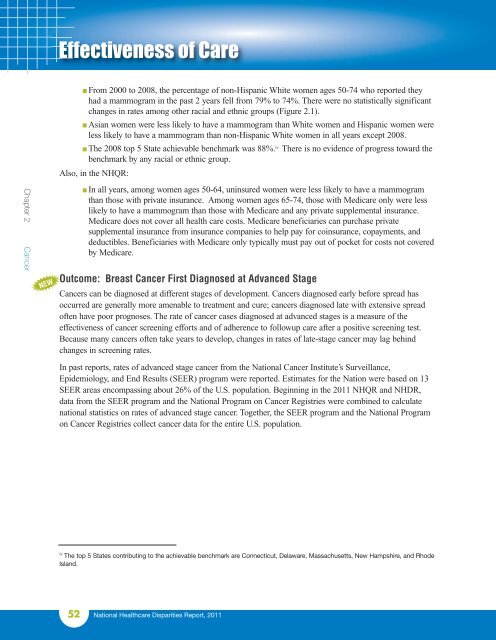National Healthcare Disparities Report - LDI Health Economist
National Healthcare Disparities Report - LDI Health Economist
National Healthcare Disparities Report - LDI Health Economist
You also want an ePaper? Increase the reach of your titles
YUMPU automatically turns print PDFs into web optimized ePapers that Google loves.
Effectiveness of Care<br />
Chapter 2 Cancer<br />
NEW<br />
n From 2000 to 2008, the percentage of non-Hispanic White women ages 50-74 who reported they<br />
had a mammogram in the past 2 years fell from 79% to 74%. There were no statistically significant<br />
changes in rates among other racial and ethnic groups (Figure 2.1).<br />
n Asian women were less likely to have a mammogram than White women and Hispanic women were<br />
less likely to have a mammogram than non-Hispanic White women in all years except 2008.<br />
n The 2008 top 5 State achievable benchmark was 88%. iv There is no evidence of progress toward the<br />
benchmark by any racial or ethnic group.<br />
Also, in the NHQR:<br />
n In all years, among women ages 50-64, uninsured women were less likely to have a mammogram<br />
than those with private insurance. Among women ages 65-74, those with Medicare only were less<br />
likely to have a mammogram than those with Medicare and any private supplemental insurance.<br />
Medicare does not cover all health care costs. Medicare beneficiaries can purchase private<br />
supplemental insurance from insurance companies to help pay for coinsurance, copayments, and<br />
deductibles. Beneficiaries with Medicare only typically must pay out of pocket for costs not covered<br />
by Medicare.<br />
Outcome: Breast Cancer First Diagnosed at Advanced Stage<br />
Cancers can be diagnosed at different stages of development. Cancers diagnosed early before spread has<br />
occurred are generally more amenable to treatment and cure; cancers diagnosed late with extensive spread<br />
often have poor prognoses. The rate of cancer cases diagnosed at advanced stages is a measure of the<br />
effectiveness of cancer screening efforts and of adherence to followup care after a positive screening test.<br />
Because many cancers often take years to develop, changes in rates of late-stage cancer may lag behind<br />
changes in screening rates.<br />
In past reports, rates of advanced stage cancer from the <strong>National</strong> Cancer Institute’s Surveillance,<br />
Epidemiology, and End Results (SEER) program were reported. Estimates for the Nation were based on 13<br />
SEER areas encompassing about 26% of the U.S. population. Beginning in the 2011 NHQR and NHDR,<br />
data from the SEER program and the <strong>National</strong> Program on Cancer Registries were combined to calculate<br />
national statistics on rates of advanced stage cancer. Together, the SEER program and the <strong>National</strong> Program<br />
on Cancer Registries collect cancer data for the entire U.S. population.<br />
iv<br />
The top 5 States contributing to the achievable benchmark are Connecticut, Delaware, Massachusetts, New Hampshire, and Rhode<br />
Island.<br />
52 <strong>National</strong> <strong><strong>Health</strong>care</strong> <strong>Disparities</strong> <strong>Report</strong>, 2011

















